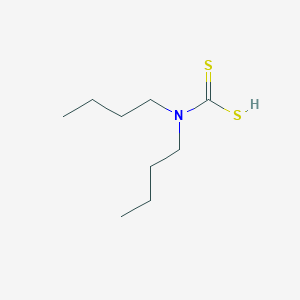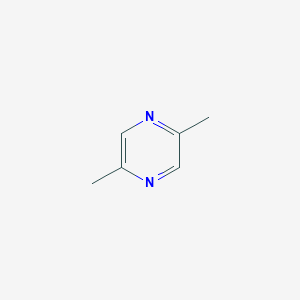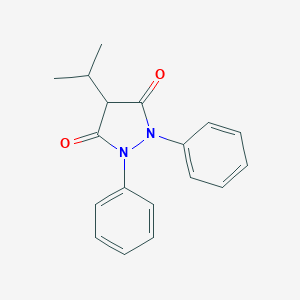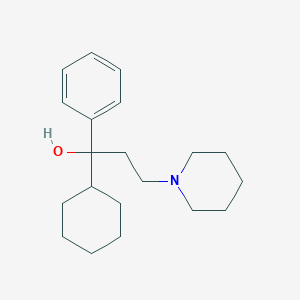
Trihexyphenidyl
描述
Trihexyphenidyl is a synthetic antispasmodic drug primarily used to manage symptoms of Parkinson’s disease and drug-induced extrapyramidal reactions. It belongs to the antimuscarinic class of medications and is known for its ability to alleviate stiffness, tremors, spasms, and poor muscle control . This compound was first approved by the FDA in 1949 and has since been a valuable tool in the symptomatic treatment of various forms of parkinsonism .
准备方法
三己苯哌啶的合成涉及几个关键步骤:
中间体丙苯酮哌啶盐酸盐的合成: 该中间体通过使用多聚甲醛和哌啶在曼尼希反应中对苯乙酮进行氨甲基化制备.
粗三己苯哌啶盐酸盐的形成: 然后将该中间体与格氏试剂反应,通常使用叔丁基甲基醚作为溶剂,以避免与二乙醚相关的安全问题.
精制: 对粗产品进行精制以获得纯三己苯哌啶盐酸盐.
化学反应分析
三己苯哌啶会经历各种化学反应,包括:
氧化: 它可以在特定条件下被氧化,但这在治疗用途方面并不常见。
还原: 还原反应不太常见,但在受控的实验室条件下可以进行。
在这些反应中使用的常见试剂包括高锰酸钾等氧化剂和氢化铝锂等还原剂。形成的主要产物取决于所用反应条件和试剂。
科学研究应用
三己苯哌啶具有广泛的科学研究应用:
作用机制
三己苯哌啶通过作为非选择性毒蕈碱乙酰胆碱受体拮抗剂发挥作用,对 M1 亚型具有更高的亲和力 。它抑制副交感神经系统,导致肌肉僵硬和震颤减少。 该药物还对平滑肌具有直接的解痉作用,并表现出较弱的瞳孔散大、抗唾液分泌和心迷走神经阻断作用 .
相似化合物的比较
属性
IUPAC Name |
1-cyclohexyl-1-phenyl-3-piperidin-1-ylpropan-1-ol | |
|---|---|---|
| Source | PubChem | |
| URL | https://pubchem.ncbi.nlm.nih.gov | |
| Description | Data deposited in or computed by PubChem | |
InChI |
InChI=1S/C20H31NO/c22-20(18-10-4-1-5-11-18,19-12-6-2-7-13-19)14-17-21-15-8-3-9-16-21/h1,4-5,10-11,19,22H,2-3,6-9,12-17H2 | |
| Source | PubChem | |
| URL | https://pubchem.ncbi.nlm.nih.gov | |
| Description | Data deposited in or computed by PubChem | |
InChI Key |
HWHLPVGTWGOCJO-UHFFFAOYSA-N | |
| Source | PubChem | |
| URL | https://pubchem.ncbi.nlm.nih.gov | |
| Description | Data deposited in or computed by PubChem | |
Canonical SMILES |
C1CCC(CC1)C(CCN2CCCCC2)(C3=CC=CC=C3)O | |
| Source | PubChem | |
| URL | https://pubchem.ncbi.nlm.nih.gov | |
| Description | Data deposited in or computed by PubChem | |
Molecular Formula |
C20H31NO | |
| Source | PubChem | |
| URL | https://pubchem.ncbi.nlm.nih.gov | |
| Description | Data deposited in or computed by PubChem | |
Related CAS |
52-49-3 (hydrochloride) | |
| Record name | Trihexyphenidyl [INN:BAN] | |
| Source | ChemIDplus | |
| URL | https://pubchem.ncbi.nlm.nih.gov/substance/?source=chemidplus&sourceid=0000144116 | |
| Description | ChemIDplus is a free, web search system that provides access to the structure and nomenclature authority files used for the identification of chemical substances cited in National Library of Medicine (NLM) databases, including the TOXNET system. | |
DSSTOX Substance ID |
DTXSID4023705 | |
| Record name | Trihexyphenidyl | |
| Source | EPA DSSTox | |
| URL | https://comptox.epa.gov/dashboard/DTXSID4023705 | |
| Description | DSSTox provides a high quality public chemistry resource for supporting improved predictive toxicology. | |
Molecular Weight |
301.5 g/mol | |
| Source | PubChem | |
| URL | https://pubchem.ncbi.nlm.nih.gov | |
| Description | Data deposited in or computed by PubChem | |
Physical Description |
Solid | |
| Record name | Trihexyphenidyl | |
| Source | Human Metabolome Database (HMDB) | |
| URL | http://www.hmdb.ca/metabolites/HMDB0014520 | |
| Description | The Human Metabolome Database (HMDB) is a freely available electronic database containing detailed information about small molecule metabolites found in the human body. | |
| Explanation | HMDB is offered to the public as a freely available resource. Use and re-distribution of the data, in whole or in part, for commercial purposes requires explicit permission of the authors and explicit acknowledgment of the source material (HMDB) and the original publication (see the HMDB citing page). We ask that users who download significant portions of the database cite the HMDB paper in any resulting publications. | |
Solubility |
Crystals; decomp at 258.5 °C; pH of 1% aq soln 5.5-6.0; solubility (g/100 mL): water at 25 °C 1.0, alcohol 6, chloroform 5; more soluble in methanol; very slightly soluble in ether, benzene /Hydrochloride/, 3.14e-03 g/L | |
| Record name | TRIHEXYPHENIDYL | |
| Source | Hazardous Substances Data Bank (HSDB) | |
| URL | https://pubchem.ncbi.nlm.nih.gov/source/hsdb/3196 | |
| Description | The Hazardous Substances Data Bank (HSDB) is a toxicology database that focuses on the toxicology of potentially hazardous chemicals. It provides information on human exposure, industrial hygiene, emergency handling procedures, environmental fate, regulatory requirements, nanomaterials, and related areas. The information in HSDB has been assessed by a Scientific Review Panel. | |
| Record name | Trihexyphenidyl | |
| Source | Human Metabolome Database (HMDB) | |
| URL | http://www.hmdb.ca/metabolites/HMDB0014520 | |
| Description | The Human Metabolome Database (HMDB) is a freely available electronic database containing detailed information about small molecule metabolites found in the human body. | |
| Explanation | HMDB is offered to the public as a freely available resource. Use and re-distribution of the data, in whole or in part, for commercial purposes requires explicit permission of the authors and explicit acknowledgment of the source material (HMDB) and the original publication (see the HMDB citing page). We ask that users who download significant portions of the database cite the HMDB paper in any resulting publications. | |
Mechanism of Action |
Trihexyphenidyl is a non-selective muscarinic acetylcholine receptor antagonist but binds with higher affinity to the M1 subtype. In vivo studies have shown that trihexyphenidyl demonstrates higher affinity for central muscarinic receptors located in the cerebral cortex and lower affinity for those located peripherally. Other studies suggest that trihexyphenidyl may modify nicotinic acetylcholine receptor neurotransmission, leading indirectly to enhanced dopamine release in the striatum. Although the anticholinergic has proven to be useful in the treatment of symptoms associated with Parkinson’s disease or other movement disorders, its mechanism of action has yet to be fully elucidated., Cerebral blood flow and oxygen metabolism were studied in six previously untreated patients with Parkinson's disease (PD) before and after anticholinergic treatment using positron emission tomography (PET) and compared with six controls. The PET study and an assessment of the disability and cognitive impairment were performed before and after administration of 6 mg trihexyphenidyl for 5 to 11 weeks. All PD patients showed improvements in motor symptoms after the trihexyphenidyl treatment. Cognitive function did not significantly differ between before and after trihexyphenidyl treatment. However, after trihexyphenidyl treatment, regional cerebral blood flow (rCBF) and regional oxygen metabolic rate (rCMRO2) decreased by 15% in the striatum and by 10% in all cortical areas contralateral to predominantly symptomatic limbs, and by 10% in the ipsilateral striatum and all cortical areas, significantly below the values of controls in most cerebral cortices and striatum. These findings suggest that trihexyphenidyl inhibits the cortical cholinergic system and significantly decreases rCBF and rCMRO2 in the cerebral cortices without cognitive impairment in untreated patients with PD., In common with other antimuscarinic agents, trihexyphenidyl produces an atropine-like blocking action on parasympathetic-innervated peripheral structures, including smooth muscle. In addition, trihexyphenidyl exhibits a direct spasmolytic action on smooth muscle and exhibits weak mydriatic, antisialagogue, and cardiovagal blocking effects. The exact mechanism of action of trihexyphenidyl in parkinsonian syndrome is not understood but may result from blockade of efferent impulses and from central inhibition of cerebral motor centers. In small doses, trihexyphenidyl depresses the CNS but larger doses cause cerebral excitement resembling the signs of atropine toxicity., In vivo microdialysis was used to study the effect of the non-selective muscarinic antagonist, trihexyphenidyl, on the decarboxylation of levodopa (L-dopa) in the striatum of hemi-Parkinson rats. In normal rats, continuous perfusion of trihexyphenidyl (1 mM) via the microdialysis probe induced a significant increase in striatal dopamine release, followed by a decrease to below baseline values. A similar effect was observed, though less pronounced, in denervated striatum of rats with a unilateral 6-hydroxydopamine lesion of the nigrostriatal pathway. In these hemi-Parkinson rats, continuous striatal perfusion of trihexyphenidyl had no effect on the biotransformation of locally applied L-dopa (2 uM for 20 min) to dopamine in either intact or denervated striatum. However, systemic administration of trihexyphenidyl (1.5 mg/kg ip) produced an attenuation of the L- dopa-induced dopamine release in the intact striatum (contralateral to the lesion) of hemi-Parkinson rats. This effect was absent in the denervated striatum of these animals. We confirmed that L-dopa induces an increase in striatal dopamine output which is influenced by the severity of the dopaminergic denervation. The absence of an effect of trihexyphenidyl locally applied in the striatum, on biotransformation of L-dopa suggests that the site of action of antimuscarinic drugs may not be in the striatum and, therefore, remains unclear. | |
| Record name | Trihexyphenidyl | |
| Source | DrugBank | |
| URL | https://www.drugbank.ca/drugs/DB00376 | |
| Description | The DrugBank database is a unique bioinformatics and cheminformatics resource that combines detailed drug (i.e. chemical, pharmacological and pharmaceutical) data with comprehensive drug target (i.e. sequence, structure, and pathway) information. | |
| Explanation | Creative Common's Attribution-NonCommercial 4.0 International License (http://creativecommons.org/licenses/by-nc/4.0/legalcode) | |
| Record name | TRIHEXYPHENIDYL | |
| Source | Hazardous Substances Data Bank (HSDB) | |
| URL | https://pubchem.ncbi.nlm.nih.gov/source/hsdb/3196 | |
| Description | The Hazardous Substances Data Bank (HSDB) is a toxicology database that focuses on the toxicology of potentially hazardous chemicals. It provides information on human exposure, industrial hygiene, emergency handling procedures, environmental fate, regulatory requirements, nanomaterials, and related areas. The information in HSDB has been assessed by a Scientific Review Panel. | |
Impurities |
1-phenyl-3-(piperidine-1-yl)propan-1-one | |
| Record name | TRIHEXYPHENIDYL | |
| Source | Hazardous Substances Data Bank (HSDB) | |
| URL | https://pubchem.ncbi.nlm.nih.gov/source/hsdb/3196 | |
| Description | The Hazardous Substances Data Bank (HSDB) is a toxicology database that focuses on the toxicology of potentially hazardous chemicals. It provides information on human exposure, industrial hygiene, emergency handling procedures, environmental fate, regulatory requirements, nanomaterials, and related areas. The information in HSDB has been assessed by a Scientific Review Panel. | |
CAS No. |
144-11-6 | |
| Record name | (±)-Trihexyphenidyl | |
| Source | CAS Common Chemistry | |
| URL | https://commonchemistry.cas.org/detail?cas_rn=144-11-6 | |
| Description | CAS Common Chemistry is an open community resource for accessing chemical information. Nearly 500,000 chemical substances from CAS REGISTRY cover areas of community interest, including common and frequently regulated chemicals, and those relevant to high school and undergraduate chemistry classes. This chemical information, curated by our expert scientists, is provided in alignment with our mission as a division of the American Chemical Society. | |
| Explanation | The data from CAS Common Chemistry is provided under a CC-BY-NC 4.0 license, unless otherwise stated. | |
| Record name | Trihexyphenidyl [INN:BAN] | |
| Source | ChemIDplus | |
| URL | https://pubchem.ncbi.nlm.nih.gov/substance/?source=chemidplus&sourceid=0000144116 | |
| Description | ChemIDplus is a free, web search system that provides access to the structure and nomenclature authority files used for the identification of chemical substances cited in National Library of Medicine (NLM) databases, including the TOXNET system. | |
| Record name | Trihexyphenidyl | |
| Source | DrugBank | |
| URL | https://www.drugbank.ca/drugs/DB00376 | |
| Description | The DrugBank database is a unique bioinformatics and cheminformatics resource that combines detailed drug (i.e. chemical, pharmacological and pharmaceutical) data with comprehensive drug target (i.e. sequence, structure, and pathway) information. | |
| Explanation | Creative Common's Attribution-NonCommercial 4.0 International License (http://creativecommons.org/licenses/by-nc/4.0/legalcode) | |
| Record name | trihexyphenidyl | |
| Source | DTP/NCI | |
| URL | https://dtp.cancer.gov/dtpstandard/servlet/dwindex?searchtype=NSC&outputformat=html&searchlist=12268 | |
| Description | The NCI Development Therapeutics Program (DTP) provides services and resources to the academic and private-sector research communities worldwide to facilitate the discovery and development of new cancer therapeutic agents. | |
| Explanation | Unless otherwise indicated, all text within NCI products is free of copyright and may be reused without our permission. Credit the National Cancer Institute as the source. | |
| Record name | Trihexyphenidyl | |
| Source | EPA DSSTox | |
| URL | https://comptox.epa.gov/dashboard/DTXSID4023705 | |
| Description | DSSTox provides a high quality public chemistry resource for supporting improved predictive toxicology. | |
| Record name | Trihexyphenidyl | |
| Source | European Chemicals Agency (ECHA) | |
| URL | https://echa.europa.eu/substance-information/-/substanceinfo/100.005.105 | |
| Description | The European Chemicals Agency (ECHA) is an agency of the European Union which is the driving force among regulatory authorities in implementing the EU's groundbreaking chemicals legislation for the benefit of human health and the environment as well as for innovation and competitiveness. | |
| Explanation | Use of the information, documents and data from the ECHA website is subject to the terms and conditions of this Legal Notice, and subject to other binding limitations provided for under applicable law, the information, documents and data made available on the ECHA website may be reproduced, distributed and/or used, totally or in part, for non-commercial purposes provided that ECHA is acknowledged as the source: "Source: European Chemicals Agency, http://echa.europa.eu/". Such acknowledgement must be included in each copy of the material. ECHA permits and encourages organisations and individuals to create links to the ECHA website under the following cumulative conditions: Links can only be made to webpages that provide a link to the Legal Notice page. | |
| Record name | TRIHEXYPHENIDYL | |
| Source | FDA Global Substance Registration System (GSRS) | |
| URL | https://gsrs.ncats.nih.gov/ginas/app/beta/substances/6RC5V8B7PO | |
| Description | The FDA Global Substance Registration System (GSRS) enables the efficient and accurate exchange of information on what substances are in regulated products. Instead of relying on names, which vary across regulatory domains, countries, and regions, the GSRS knowledge base makes it possible for substances to be defined by standardized, scientific descriptions. | |
| Explanation | Unless otherwise noted, the contents of the FDA website (www.fda.gov), both text and graphics, are not copyrighted. They are in the public domain and may be republished, reprinted and otherwise used freely by anyone without the need to obtain permission from FDA. Credit to the U.S. Food and Drug Administration as the source is appreciated but not required. | |
| Record name | TRIHEXYPHENIDYL | |
| Source | Hazardous Substances Data Bank (HSDB) | |
| URL | https://pubchem.ncbi.nlm.nih.gov/source/hsdb/3196 | |
| Description | The Hazardous Substances Data Bank (HSDB) is a toxicology database that focuses on the toxicology of potentially hazardous chemicals. It provides information on human exposure, industrial hygiene, emergency handling procedures, environmental fate, regulatory requirements, nanomaterials, and related areas. The information in HSDB has been assessed by a Scientific Review Panel. | |
| Record name | Trihexyphenidyl | |
| Source | Human Metabolome Database (HMDB) | |
| URL | http://www.hmdb.ca/metabolites/HMDB0014520 | |
| Description | The Human Metabolome Database (HMDB) is a freely available electronic database containing detailed information about small molecule metabolites found in the human body. | |
| Explanation | HMDB is offered to the public as a freely available resource. Use and re-distribution of the data, in whole or in part, for commercial purposes requires explicit permission of the authors and explicit acknowledgment of the source material (HMDB) and the original publication (see the HMDB citing page). We ask that users who download significant portions of the database cite the HMDB paper in any resulting publications. | |
Melting Point |
114 °C, 258.5 °C | |
| Record name | Trihexyphenidyl | |
| Source | DrugBank | |
| URL | https://www.drugbank.ca/drugs/DB00376 | |
| Description | The DrugBank database is a unique bioinformatics and cheminformatics resource that combines detailed drug (i.e. chemical, pharmacological and pharmaceutical) data with comprehensive drug target (i.e. sequence, structure, and pathway) information. | |
| Explanation | Creative Common's Attribution-NonCommercial 4.0 International License (http://creativecommons.org/licenses/by-nc/4.0/legalcode) | |
| Record name | TRIHEXYPHENIDYL | |
| Source | Hazardous Substances Data Bank (HSDB) | |
| URL | https://pubchem.ncbi.nlm.nih.gov/source/hsdb/3196 | |
| Description | The Hazardous Substances Data Bank (HSDB) is a toxicology database that focuses on the toxicology of potentially hazardous chemicals. It provides information on human exposure, industrial hygiene, emergency handling procedures, environmental fate, regulatory requirements, nanomaterials, and related areas. The information in HSDB has been assessed by a Scientific Review Panel. | |
| Record name | Trihexyphenidyl | |
| Source | Human Metabolome Database (HMDB) | |
| URL | http://www.hmdb.ca/metabolites/HMDB0014520 | |
| Description | The Human Metabolome Database (HMDB) is a freely available electronic database containing detailed information about small molecule metabolites found in the human body. | |
| Explanation | HMDB is offered to the public as a freely available resource. Use and re-distribution of the data, in whole or in part, for commercial purposes requires explicit permission of the authors and explicit acknowledgment of the source material (HMDB) and the original publication (see the HMDB citing page). We ask that users who download significant portions of the database cite the HMDB paper in any resulting publications. | |
Retrosynthesis Analysis
AI-Powered Synthesis Planning: Our tool employs the Template_relevance Pistachio, Template_relevance Bkms_metabolic, Template_relevance Pistachio_ringbreaker, Template_relevance Reaxys, Template_relevance Reaxys_biocatalysis model, leveraging a vast database of chemical reactions to predict feasible synthetic routes.
One-Step Synthesis Focus: Specifically designed for one-step synthesis, it provides concise and direct routes for your target compounds, streamlining the synthesis process.
Accurate Predictions: Utilizing the extensive PISTACHIO, BKMS_METABOLIC, PISTACHIO_RINGBREAKER, REAXYS, REAXYS_BIOCATALYSIS database, our tool offers high-accuracy predictions, reflecting the latest in chemical research and data.
Strategy Settings
| Precursor scoring | Relevance Heuristic |
|---|---|
| Min. plausibility | 0.01 |
| Model | Template_relevance |
| Template Set | Pistachio/Bkms_metabolic/Pistachio_ringbreaker/Reaxys/Reaxys_biocatalysis |
| Top-N result to add to graph | 6 |
Feasible Synthetic Routes
体外研究产品的免责声明和信息
请注意,BenchChem 上展示的所有文章和产品信息仅供信息参考。 BenchChem 上可购买的产品专为体外研究设计,这些研究在生物体外进行。体外研究,源自拉丁语 "in glass",涉及在受控实验室环境中使用细胞或组织进行的实验。重要的是要注意,这些产品没有被归类为药物或药品,他们没有得到 FDA 的批准,用于预防、治疗或治愈任何医疗状况、疾病或疾病。我们必须强调,将这些产品以任何形式引入人类或动物的身体都是法律严格禁止的。遵守这些指南对确保研究和实验的法律和道德标准的符合性至关重要。


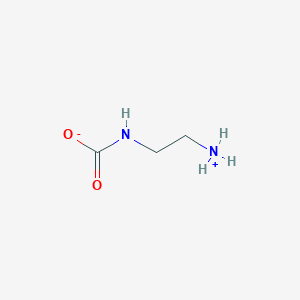

![1,4,6,9-Tetraoxa-5lambda~4~-telluraspiro[4.4]nonane](/img/structure/B89650.png)
